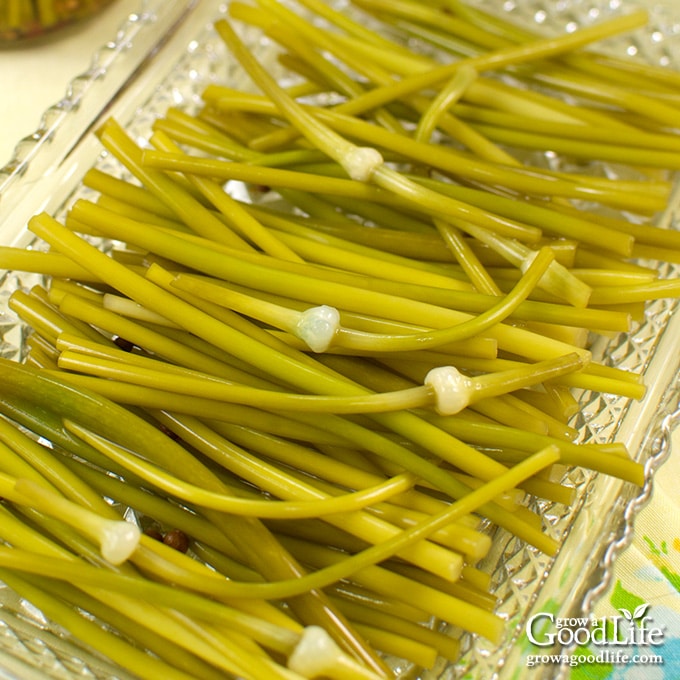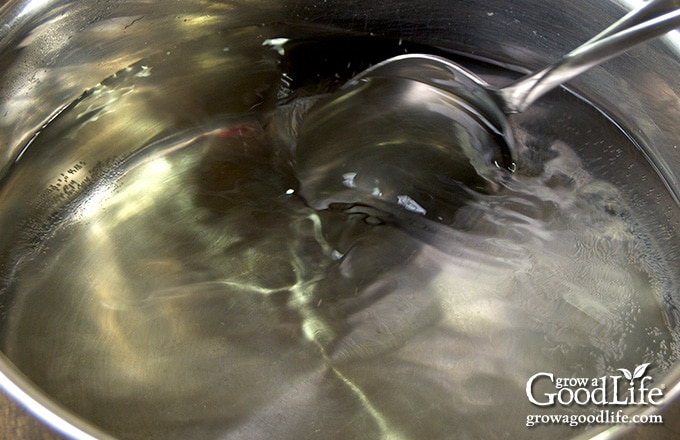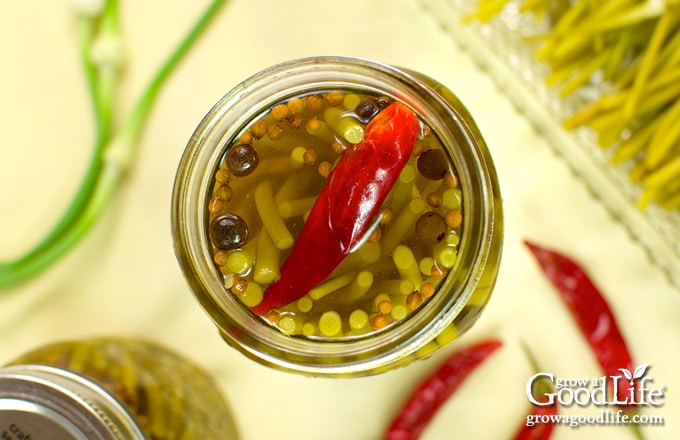Pickled Garlic Scapes Recipe
This post may contain affiliate links, which means that I may receive a commission if you make a purchase using these links. As an Amazon Associate I earn from qualifying purchases.
If you enjoy pickles and garlic, you are going to love the flavor of these pickled garlic scapes. Learn how to preserve garlic stems as pickles and enjoy as a snack, sandwich topping, or on a charcuterie board.

If you grow hardneck garlic you are in for a treat because the plant provides two harvests. Several weeks before the garlic is ready for harvesting, it sends up a flower stalk. This usually happens in late spring or early summer, depending on your growing location and variety of garlic.
The stalk sprouts from the center of the garlic plants, and grows upwards for a while, and then curls once or twice before continuing to grow towards the sky. If left alone, it will bloom into a garlic flower.
However, most growers remove the garlic stems before it blossoms so the plants can devote energy into developing larger garlic bulbs. The garlic scape itself is edible and has a mild garlic flavor with a hint of sweetness.
If you don’t grow your own garlic, you may have spotted the squiggly stems at your local farmers market, or in your CSA box in early summer. They are usually sold in bunches and can be stored in the refrigerator for several weeks.
Tips for Making Pickled Garlic Scapes
My favorite way to use garlic scapes is to turn them into garlic scape pickles. The stems stay crisp and crunchy after processing, and they are delicious as a snack, sandwich topping, or blended into a salad dressing.
In this recipe, garlic scapes are preserved in a vinegar brine flavored with pickling spice, salt, and a little bit of chili pepper for some spicy heat. Then the garlic stems are processed in a boiling water bath canner for shelf stable jars. Here are tips for making pickled garlic scapes:
Harvest Young Scapes
For tender scapes, harvest the stems after the first loop forms. If picked a little later, the base develops a woody texture, making it difficult to chew. You can remove this woody part and freeze it to use when making stocks. See How to Harvest Garlic Scapes for more details.

Store in Refrigerator
If you are not ready to use your garlic scapes right away, place the stems in a glass of water and store in the fridge. Change the water every few days, and plan on using the garlic scapes in the next week or so for the best quality.
Use Pickling Salt
Pickling salt, also known as canning salt, is just pure granulated salt (sodium chloride) with no additives. Avoid using table salt because it contains iodine and anti-caking agents that can darken food and make jars cloudy.
Choose Type of Vinegar
Use commercial vinegar with at least 5% acidity for pickling food. The most common types used for canning are apple cider and white vinegar:
- Apple cider vinegar is made from fermented apples and adds a light sweet apple flavor to your pickles
- White vinegar is clear vinegar made by distilling corn and rye. The flavor is bit sharper than apple cider vinegar. Choose an organic brand to avoid genetically modified corn.
Don’t Have a Water Bath Canner?
If you don’t have a water bath canner, you can use a large pot to process the jars of pickled garlic scapes. For small batch canning, I use an 8-quart tall pot with an 8-inch canning rack. It holds 4 pint-sized canning jars.
Your pot will need to be tall enough to cover the tops of the jars by a few inches of water, plus two inches of space to prevent boiling water from splashing out of the pot. Place a rack in the bottom to elevate the jars up away from direct heat, and allow the water to circulate around the jars as they are processed.
Other Ways to Use Garlic Scapes
If you are growing a lot of garlic, you will end up with an abundance of garlic scapes since they usually form all at the same time. Luckily, there are many ways to enjoy garlic stems from garlic scape pesto, to grilled garlic scapes, and as a substitute for garlic in any recipes. Check out this article for more delicious ways to use garlic scapes: 10 Garlic Scape Recipes
How to Make Picked Garlic Scapes
Garlic scapes are only around for a short time. Preserve their mild garlic flavor with this pickled garlic scapes canning recipe. Layer on sandwiches and burgers, serve as a side dish with grilled meats, or as part of a classic pickle tray. My favorite way to enjoy pickled garlic scapes is simply snacking right out of the jar.
Before you begin, you may find it helpful to review this article on water bath canning at the National Center for Home Food Preservation. The full and printable recipe can be found at the bottom of this article, but these are the steps for making and canning pickled beans.
Step 1: Prepare the Canning Equipment
Gather your kitchen and canning equipment, prepare the jars, set up the canner, and organize your work area.
You’ll need:
- Water bath canner or a large pot (8 quart tall) with a rack
- 4 pint sized canning jars
- Lids and bands (new lids for each jar, bands can be reused)
- Canning tools: jar lifter, canning ladle, funnel, and bubble popper
- Plus basic kitchen supplies such as a large prep bowl, knife, cutting board, medium pot, and several clean kitchen towels
Wash your jars, lids, bands, and canning tools in warm, soapy water and rinse well. Set the lids, bands, and tools aside to air dry on a towel until you are ready to use them.
Jars must be warm before filling to prevent a fluctuation in temperature that may cause the jars to break. Place the jar rack into the canner, set the jars upright on the rack, and add water to cover the jars. Bring the canner to a simmer (180˚F) for 10 minutes, and keep the jars hot until you are ready to fill them.
Follow the manufacturer’s directions for preparing the lids. Pre-heating lids is not necessary before using, but it is still safe to simmer (180°F) the lids if you want to. Just add them to the canner when you heat your jars.

Step 2: Prepare the Garlic Scapes
Rinse the garlic scapes and cut into 4-inch long pieces to fit in the jar. If the ends of the garlic scapes are fibrous and woody, remove them by bending the stalk the same way you would asparagus. Gently bend each stalk until it snaps. Each scape will snap off right above the spot where it turns woody. Save the ends of the scapes in the freezer, and use to flavor homemade stock.
Step 3: Heat the Pickling Liquid
Combine the vinegar, water, and pickling salt in a medium pot. Cover, bring to a boil, and then reduce the heat and simmer (180˚F) for 10 minutes. Keep the brine warm.

Step 4: Pack the Jars
When you are ready to fill the jars, spread a dry kitchen towel on the counter, and place the spices and measuring spoons nearby.
Use the jar lifter to remove a hot jar from the canner, pour the water back into the pot, and place on the towel. Keep the remaining jars in the canner, so they stay warm.
Add 1 teaspoon pickling spice mix, 1/4 teaspoon red pepper flakes or 1 whole dried chili pepper, and 1 dried bay leaf to the jar.
If you don’t have pickling spice on hand, you can substitute 1/2 teaspoon mustard seed, 1/4 teaspoon black peppercorns, 1/4 teaspoon coriander seeds, 2 whole allspice berries, and 2 whole cloves.
Pack the stems lengthwise into the jar. It may help to turn the jar on its side, and stack the scapes inside. Place the funnel on the top of the jar, and ladle the hot brine over the garlic scapes, leaving 1/2 inch headspace.
Poke the bubble popper through the jar to release air bubbles. You can also tilt the jar back and forth to help air escape. Add more brine to adjust the headspace again if needed. You want to be sure all the stems are submerged completely in the brine.
Wipe the rim with a damp towel to remove residue. Center a lid on the jar, place the band over the lid, and screw it on until fingertip tight. Place the jar back into the canner, and repeat with the rest of the jars.
Step 5: Process the Jars
Once all the jars are in the canner, adjust the water level so it is covering the tops of the jars by two-inches. Cover, bring to a boil, set the timer, and process the jars for the times indicated in the recipe below.
Once the processing time is complete, turn off the heat, remove the cover, and let the canner cool for 5 minutes. Use the jar lifter to remove the jars, place them on a dry towel, and let them cool completely. Test the seals, label and date the jars, and store in a cool, dark location for 12 to 18 months. Allow 2 to 4 weeks before opening for the flavor to develop. Use within 12 to 18 months.


Pickled Garlic Scapes Canning Recipe
Ingredients
- 4 pounds garlic scapes
- 3 cups apple cider vinegar 5% acidity
- 3 cups water
- 1/4 cup pickling salt
- 4 teaspoons pickling spice 1 teaspoon per jar
- 4 bay leaves 1 per jar
- 1 teaspoon red pepper flakes or 4 whole dried chili peppers, 1/4 teaspoon per jar or 1 whole pepper per jar
Instructions
Prepare the Canning Equipment:
- Wash your jars, lids, screw bands, and canning tools in hot soapy water. Rinse thoroughly to remove all suds. Set aside to air dry on a clean kitchen towel.
- Place the canning rack into water bath canner, place the jars in the canner, and add water to cover. Bring the canner to a simmer (180˚F) for 10 minutes, and keep the jars warm until you are ready to fill them.
Prepare the Garlic Scapes:
- Rinse garlic scapes and cut into 4-inch pieces to fit in the jar. Discard the top of the flower and tough ends (or toss into a freezer bag and save to use for making stock).
Make the Pickling Brine:
- Add the vinegar, water, and pickling salt to a medium pot and stir to combine. Bring to a boil, and then reduce the heat and simmer (180˚F) for 10 minutes. Keep the brine warm.
Can the Pickled Garlic Scapes:
- Spread a dry towel on the counter. Use the jar lifter to remove a jar from canner. Drain and place on the towel. Keep the remaining jars in the canner, so they stay warm.
- Add 1 teaspoon pickling spice mix, 1/4 teaspoon red pepper flakes or 1 whole dried chili pepper, and 1 dried bay leaf to the jar.
- Pack the garlic stems lengthwise into the jar. It may help to turn the jar on its side, and stack the scapes inside. Try to pack as tightly as you can.
- Place the funnel on the top, and ladle the hot brine over the garlic scapes, leaving 1/2 inch of headspace.
- Run the bubble popper through to release any trapped air bubbles. You can also tilt the jar back and forth to let air escape. Add more brine to adjust the headspace again if needed to maintain a 1/2 inch. You want to be sure all the stems are beneath the brine.
- Wipe the rim with a damp towel, center a lid on the jar, place the band over the lid, and screw it on until fingertip tight.
- Place the jar back into your canner, and repeat with the rest of the jars.
- Once the jars are in the canner, adjust the water level so it is 2-inches above the tops of the jars.
- Cover the canner, and bring it to a boil over high heat. Once the water boils vigorously, set a timer, and continue boiling for 10 minutes at altitudes of less than 6,000 feet. Adjust processing time for your altitude if necessary (See Notes).
- When processing time is complete, turn off heat, remove the cover, and let the canner cool down and settle for about 5 minutes.
- Spread a dry kitchen towel on the counter. Remove the cover by tilting lid away from you so that steam does not burn your face.
- Use the jar lifter to remove the jars from canner and place on the towel. Keep upright, and don't tighten bands or check the seals yet. Let the jars sit undisturbed for 12 to 24-hours to cool.
- After 12 to 24-hours, check to be sure the lids have sealed by pushing on the center. The lid should not pop up. If the lid flexes up and down, it did not seal. Refrigerate and use up within 3 months.
- Remove the screw on bands and wash the jars. Label, date, and store your jars in a cool, dark place for 12 to 18 months. Allow 2 to 4 weeks for the pickled garlic scapes to develop their flavor. Once the jar is open, store in the refrigerator for up to 3 months. Recipe makes about 4 pints.
Notes
Nutrition
You May Also Like:
Good planning is key to a successful vegetable garden
Whether you are new to growing your own food or have been growing a vegetable garden for years, you will benefit from some planning each year. You will find everything you need to organize and plan your vegetable garden in my PDF eBook, Grow a Good Life Guide to Planning Your Vegetable Garden.


Can you substitute the garlic scapes for the green beans in dilly bean recipe ( to make dilly garlic scapes?)
Lori, Yes, it is safe to use the dilly beans recipe to pickle garlic scapes.